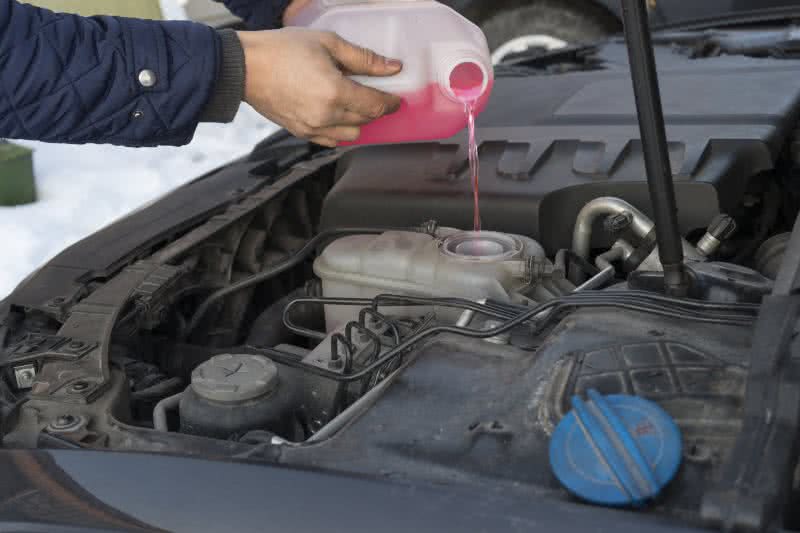Coolant is a fluid which is added to your cars radiator to prevent the engine from overheating. Without coolant, the engine would overheat within minutes. However, as with all the fluids that you add to your car, there is no “one size fits all” and there are a lot of different properties to consider when deciding which coolant to use in your car.
Below we are going to be discussing everything which you need to know about coolants.

What Are The Different Types Of Coolant?
When it comes to selecting a coolant, there are two things which you should take into account. First, you have to find what type of coolant you need. Second, you must find out what the base of the coolant is.
First, the type of coolants, there are two main types of coolant, Type A and Type B.
- Type A coolant contains an antifreeze / anti-boil component. This is typically either ethylene glycol and is used to decrease the coolant’s freezing point and raise its boiling point. A variety of different inhibitor packages are used in Type A coolants and depending on its application, different doses of glycol are used.
- Type B coolant is similar to Type A coolant, and contains very small amounts of the additives that Type A (around 5-10%) does and is used more commonly as a rust inhibitor and not as a “coolant.”
The most common types of antifreeze which are used today include; Ethylene Glycol and Organic Acid Technology. When you’re out shopping for a coolant you’ll see a lot of different colours, but don’t let that scare you.
Coolant is a transparent fluid and different manufacturers add dyes to differentiate the coolant base. Always remember to read your car’s owner manual before you add a coolant to the car. The most common colours you will come across are green, red, blue, yellow or orange.
Green coolant is your conventional coolant (Ethylene Glycol base) and is the most common type of coolant found.
Red coolant is typically has a base of Organic Acid Technology which has a different chemical makeup of green coolant and is designed to be suitable for aluminium radiators. Red coolant is often silicate and phosphate free for use in later Japanese and Euro vehicles.
Blue coolant is usually an Organic Acid Technology base and what makes it different from red coolant is that they’re normally Borate free which is a requirement for modern day Japanese vehicles that are supplied with blue coolant from factory.
Yellow or Orange coolants are the latest in technology and are normally a universal product. Some universal coolants will allow top up mixing to a certain percentage of the overall capacity of the cooling system, so it’s important to keep this in mind when topping up.
How Long Does Coolant Last?
Coolants typically contain something known as a “rust inhibitor” which is used to prevent components within the engine from rusting. This can lead to the coolant becoming flooded with contaminants which contribute to the deterioration of the anti-boiling and anti-freeze additives which are in the coolant.
There are a few different factors to consider when determining how long coolant lasts and when it should be changed. The two main factors are the type of car that you drive and the quality of your cars current coolant. Many manufacturers suggest that you change the coolant every 3 years or every 75,000km, while others say that you can change the coolant every 200,000km.
How often you change the coolant can also depend on how well you take care of your car and whether or not there are any underlying issues with it.
What Coolant Do I Use For My Car?
As we previously mentioned, when it comes to the coolant you must make sure that you’re using the right one. If you use the wrong coolant then over time you’ll begin to notice a drop in your car's performance, and can find a significant amount of damage.
While this isn’t a guaranteed way to discover which coolant you should use, the most common method is to simply check the coolant and find out what colour it is. Most coolant brands will keep their coolants the same colour to prevent any confusion.
Can I Mix Different Coolants?
Provided that the coolants which you are using have identical chemical makeup (for example, if two coolants are based on Ethylene Glycol), then it is normally safe for you to mix them together. If you aren’t certain on which base the current coolant that you have in your car uses, there are universal mixes available.
If you don’t have access to a coolant then water may be used in place of it. However, it’s very important to keep in mind that water’s boiling point is significantly lower than a coolant’s and therefore, is less effective. Furthermore, coolants have rust-resistant properties whereas water does not.
*Important information* - Click here to read more about our How-To terms and conditions.
